Great Taste Trail - Heart of Biking
Last updated 11 March 2023

When it comes to off road cycling there are a wide variety of options across the Top of the South for both mountain biking and trail riding. When the Government’s National Cycleway programme was launched in 2010, the two projects chosen for investment in Nelson/Tasman region were the Copper Mine Trail, nominated as one of New Zealand's “Great Rides,” and the Great Taste Trail, which standing alone was a significant development project.
The Copper Mine Trail is a 43 kilometre mountain bike trail including a section on the Dun Mountain railway bench which provided the base for the first railway in New Zealand, with it opening in 1860. It was 21.7 kilometres in length and was built to provide access for the Dun Mountain Copper Mining Company to extract Chromite deposits on Dun Mountain. The wagons were drawn by horses up the line and the full wagons travelled down in pairs under gravity with brakes to slow their descent.
Initially, the Dun Mountain was mined for Copper then later Chromite.The Chromite mine was at best an ill-conceived venture as the reserves were totally over-estimated with the result the company was wound up in 1872. 2,500 acres of the land originally belonging to the mining company was resold through a series of owners until it was purchased in 1912 by Thomas Cawthron, a prominent businessman, visionary and philanthropist, who donated it to the city as a reserve. The gifting of the land came with “all rights of road over the old Dun Mountain Tramway line, and all rights of road through Section 6, Maungatapu Survey District, in the valley of the South Maitai”
A number of conditions were attached including that:
- The land be held as a reserve for recreation purposes.
- The reserve be a sanctuary for native flora and fauna, especially bird life, and that the harm of birds within it be strictly prohibited.
It was decided to name the gifted area “The Cawthron Park.” The Coppermine Trail runs up the tramway to 3rd House, through The Cawthron Park and then utilizes the road access rights to the South Maitai valley.
The rail bench also runs along the Northern and part of the Eastern boundary of the Brook Waimarama Sanctuary, to third house. It is fitting therefore that the area of the original water work’s reserve below the Dun Mountain Rail bench is the site of a sanctuary devoted to recovery of endangered native birds, native forest and insect life. As the populations of species increase, they will spread out from the protection of the fenced sanctuary into the surrounding hills including The Cawthron Park, helping further fulfill the vision of Thomas Cawthron.
With the start of this trail only 2.5 kilometres from the city centre, it is the most easily accessible of the “Great Rides” in New Zealand.
-1.jpg?alt=media&token=54caa0f3-a9b6-469d-82f6-7da8c8913d29)
Route of the Great Taste Trail
Though there was some upgrading of the Coppermine trail the bulk of the Government funding was focused on the development of the Great Taste trail.
The Great Taste trail is now 200 kilometres in length and can be explored in sections or ridden as a loop track through a multi-day ride with extensions off the loop from Nelson CBD up the Maitai valley and from Motueka, then Riwaka to Kaiteriteri beach, one of the region’s most popular visitor destinations. The coastal section of the trail passes around the Waimea inlet, along Rabbit Island to link to Mapua then through Tasman and Motueka to ultimately reach Kaiteriteri which is also home to one of the region’s popular mountain bike parks.
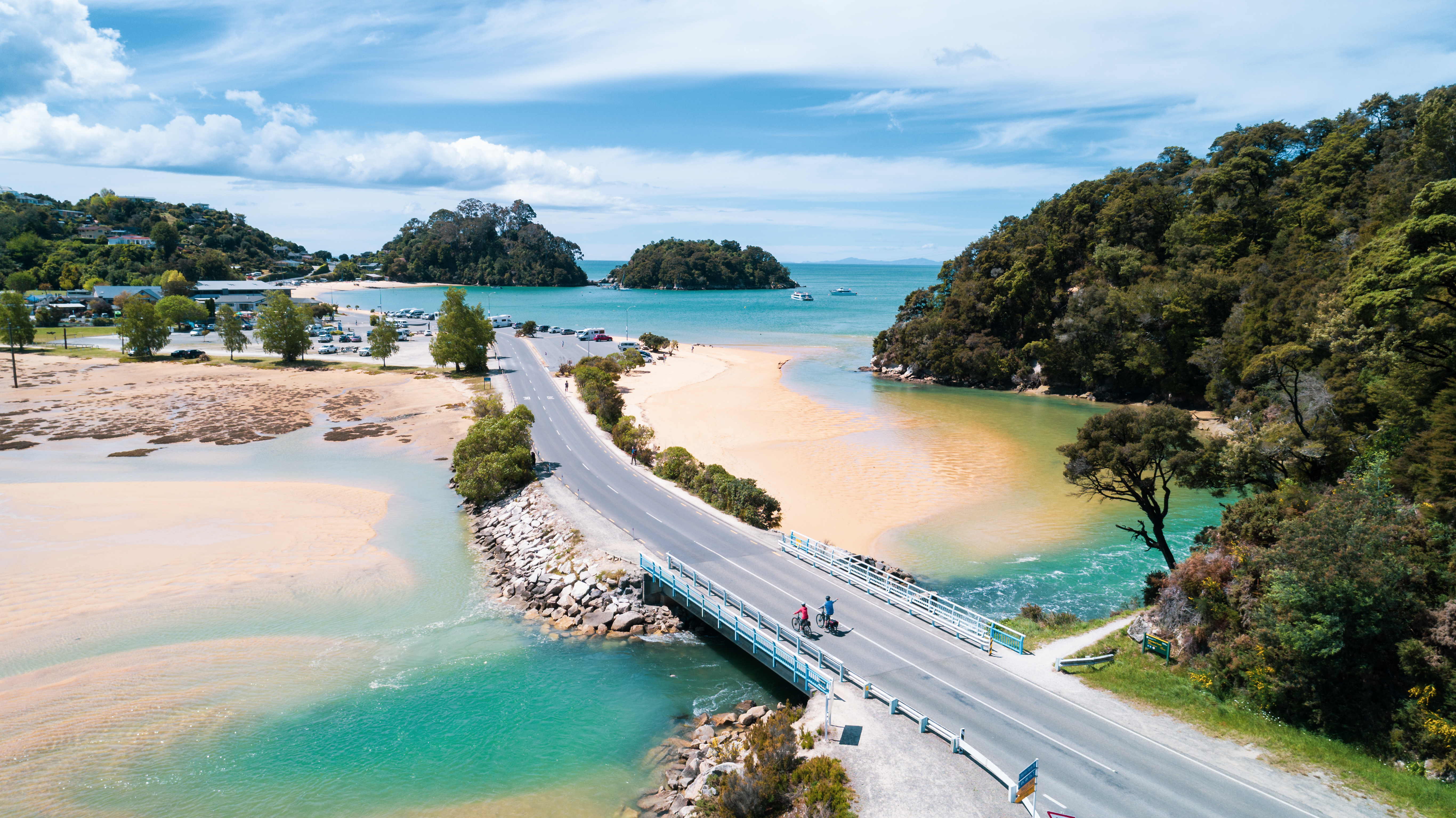
A relaxing day at Kaiteriteri's famed golden beach
Kaiteriteri provides an entry point to the Abel Tasman National Park via water taxis operated from the beach and is only 11 kilometres from the start of the walking track at the Northwestern end of Marahau village.
The Great Taste Trail showcases the stunning coastline of Tasman Bay, the picturesque inland rural areas passing by orchards, vineyards and the towns of the Waimea plains including Richmond, Brightwater and Wakefield. It then links through the Spooners Tunnel to Kohatu then branching down through Tapawera (passing by hop gardens) and Batton valley to Woodstock. Finally, it passes down the Motueka River Valley, West Bank to complete the circuit in Riwaka. Riwaka is another highly fertile area supporting orchards and hop gardens as well as hill farms.
Some of the other Trail highlights include:
The Waimea Inlet
The board walks, track benches and bridges take you through the wetlands on the edge of the inlet. The inlet is an internationally important coastal habitat. It is one of the locations in Tasman Bay, visited by the world-famous bar-tailed godwit (kuaka) to feed and which travels 11000 kilometres direct from Alaska to the region. One of their favourite nesting sites in New Zealand is on the Motueka sandspit and estuary, further along the trail, where the birds stay for 6 months before making their journey back to Alaska.

Waimea Estuary Bridge
The Waimea inlet provides a plentiful food source and at the last bird count there were over 50 species visiting, many of which are endangered. These include a number of species of wading birds as well as sea birds which can be seen from the trail. Wading birds include the beautiful white heron (kotuku), the royal spoon bill (kotuku-ngutupapa), banded rail (mono pereru). Seabirds include the black billed gull (tarapuka), black fronted tern (tarapihoe) and the blue penguin (Korora). From the inlet the trail links onto the causeway road over Rough Island then onto Rabbit Island (Moturoa).
The Inlet, Rabbit Island and Rough Island are part of a significant project led by the Tasman Environmental Trust to plant areas on the seashore with 100,000 hardy native trees that will help protect the coastal areas.
Rabbit Island to Mapua
Once cyclists have explored the island and/or had a swim they can take the Bike Ferry which operates in the summer to arrive near Mapua Wharf some 10 minutes later. Mapua is one of the highlights of the coastal trail and has a number of great cafes, shops and art galleries plus a wine bar where you can relax and enjoy some local wines.

Crossing over from Rabbit Island to Mapua via bike ferry
Stopping over in Mapua Wharf, a must visit destination on The Great Taste Trail
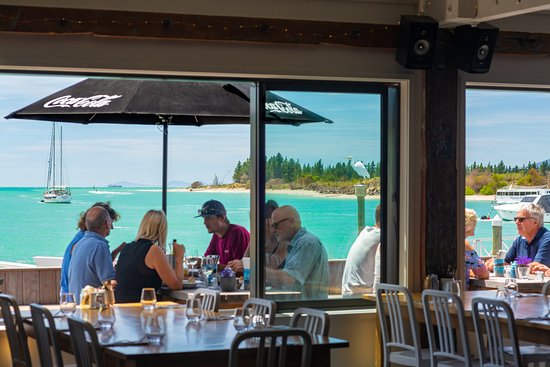
Jellyfish in Mapua is an excellent place to grab a bite to rejuvenate for the next length of your trip
The inland route. The Spooners Tunnel, at 1.4 kilometres, is the longest decommissioned tunnel in New Zealand. When you enter the tunnel, you cannot see the end as it rises towards the middle then slopes down to the end. It is necessary to have a head lam or other light on the bike with the tunnel fitted with reflectors to help define the trail ahead.
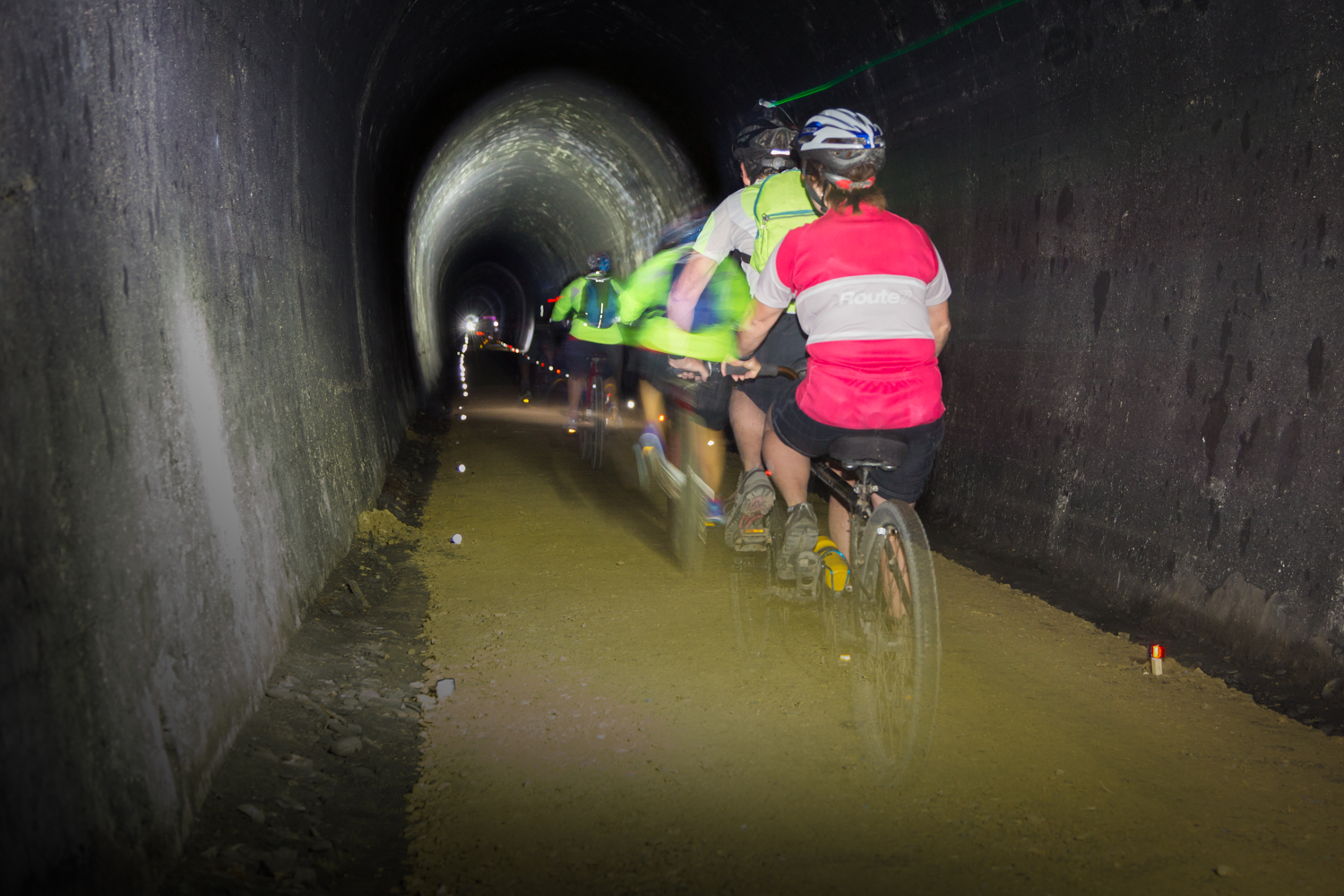
Huddling together through the iconic spooner's tunnel
Kohatu is a good stop off point for a drink and a bite to eat because beyond Tapawera there are no further settlements on the run through the Baton Valley and Motueka River valley where cyclists can enjoy some of the solitude with only a small number of vehicles where the Trail shares back country roads.
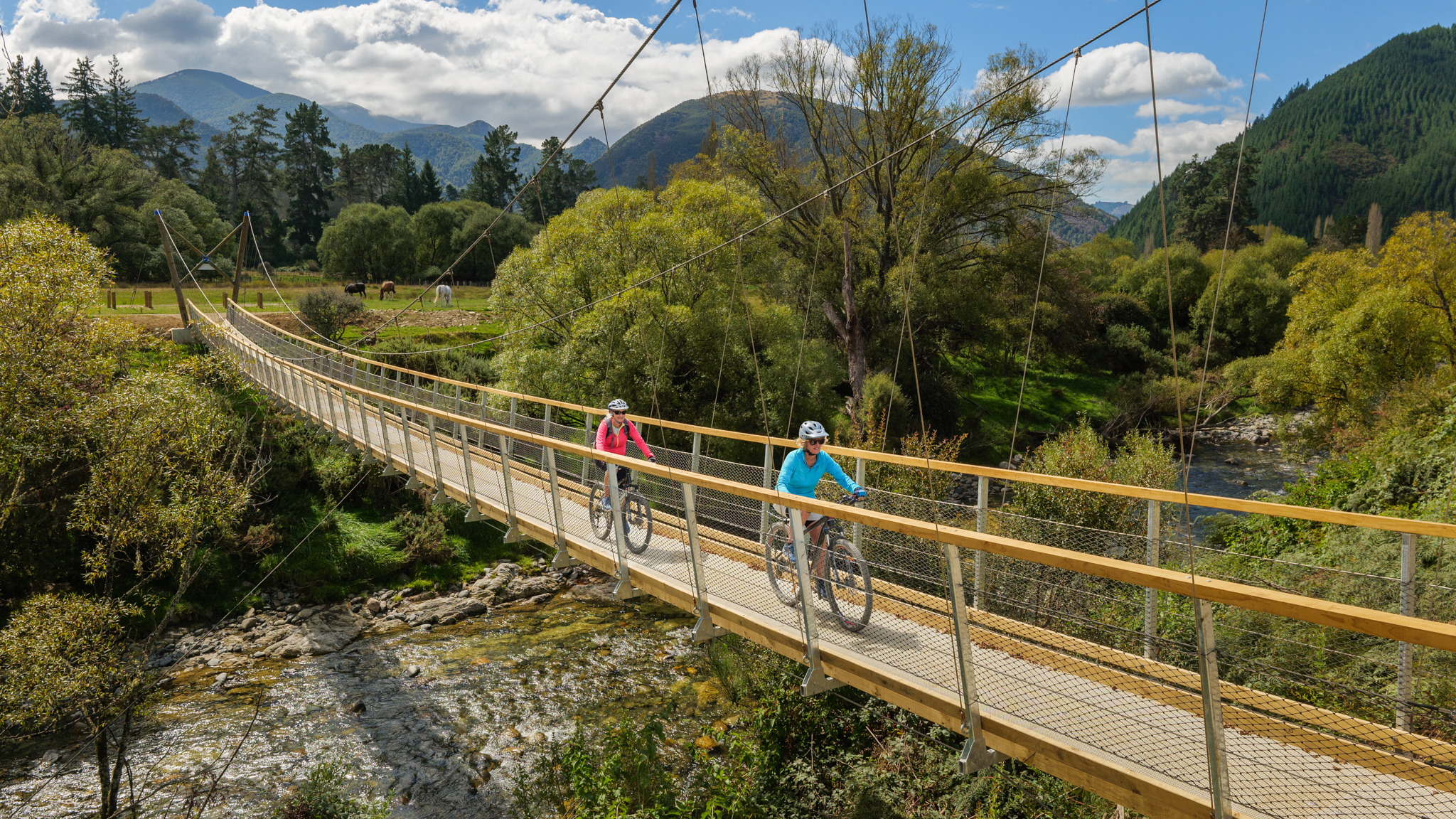
High up on the Baton Valley bridge
To enjoy everything Nelson/Tasman has to offer, visitors need to do some research of other attractions in the region near the trails including bars and cafes, which feature boutique beers or wines, the amazing Pic’s Peanut Butter factory.
Monaco is an interesting peninsula that riders can explore as a side trip on the ride out of Nelson. There are further opportunities around Richmond, Brightwater and in Wakefield to stop, refresh or browse with interesting cafes, shops, or art galleries to visit.
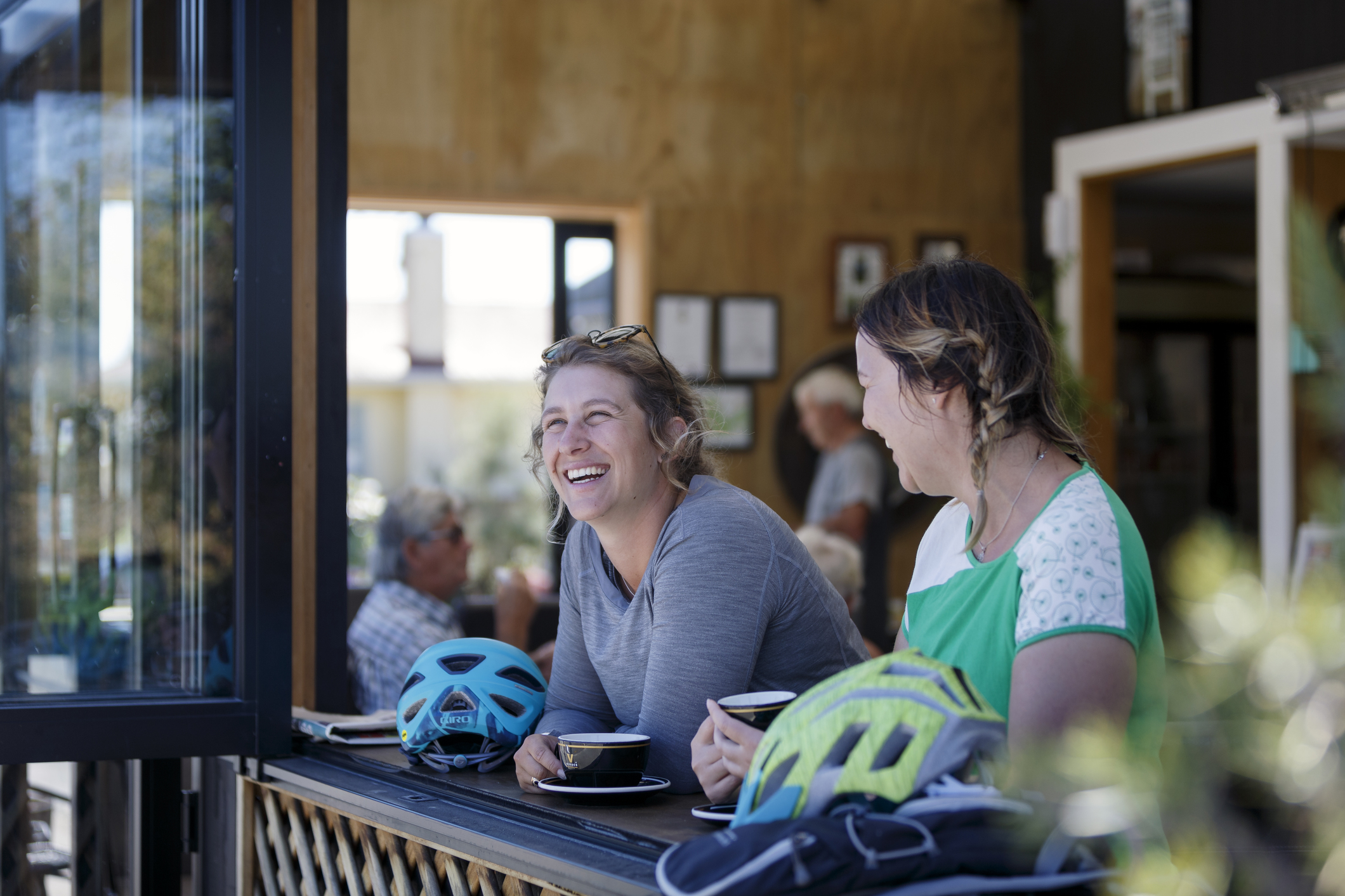
Stopping over for a chat in the sun
Nelson City also features art with a number of galleries including The Suter Art Gallery Te Aratoi o Whakatū, the flagship public art gallery for the region. Art works from The Suter collection are also featured on the walls of buildings on an “ArtWalk” of works by some of Nelson’s celebrated artists.
Nelson Rotary again considered Great Taste Trail project a significant opportunity for Nelson Tasman and became actively involved in work on first 2 stages of the trail development includineg building sections of board walk on the Waimea estuary as a club-only project in 2012 then joining the other clubs including Nelson West Rotary, The Rotary Club of Whakatu and the Rotary Club of Richmond at various times doing further boardwalks in 2012 and 2013. In 2013 work this included a board walk near Best Island and also nailing off decking on bridges. In 2014 and 2015 the club was involved in joint working parties building the entry platform and doing the lighting in the Spooners Tunnel.
Our team delivering the finishing touches
The club also responded to a call for help from the Cycleway Trust in early February in 2018 when Cyclone Fehi severely damaged the board walk sections of the trail. Initially the club carried out club-only working bees but was then joined by Nelson West and Richmond to complete the recovery work and later to do some of the work nailing down the planking once the support structures had been reinstated by contractors.
The trail is highly successful with recent audits showing there are now over 300,000 cyclists using the trail each year. The popularity of the region as a lifestyle centre means the trail is much loved by locals who bring a strong contribution to the numbers using the trail.
The Rotary Club of Nelson in turn remains a strong supporter of the Cycle Trail and will be taking part in further planned enhancements including in a plan to erect up to 5 shelters along the trail during 2022.
Recently, we helped erect six new shelters. You can read more about this below:
https://nelsonapp.co.nz/news/six-new-shelters-for-great-taste-trail



